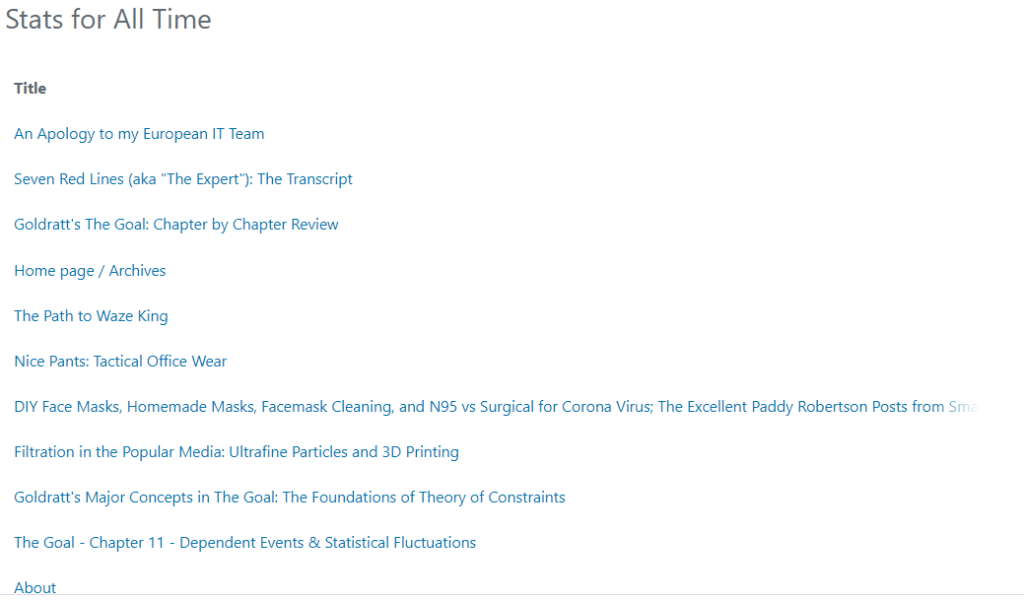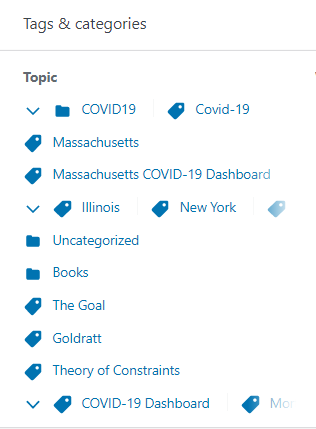Communicating complex ideas clearly is a valuable skill; skills improve with practice. I started this blog in 2010 without any goals and shifted to using it as a place to deliberately improve my communication skills. I followed four steps:
- Choose a Goal
- Pick a Metric
- Create a Method
- Follow the Numbers
Focus has been a huge help (Goldratt Concepts). I’ve been really pleased by how summarizing my personal thoughts for public feedback has helped develop thoughts that have served as the foundation for my professional career. What began as an undirected attempt to share my observations on domains where my background is unique, has shifted to taking those unique perspectives and applying them systematically to broader areas of society which attract a larger readership.
Background
As part of finishing my MBA from UNC in 2005, I’d written some papers around private equity and economics that we were using in the early days of marketing Parish Capital. I registered my own name as a domain and was using the blog hosting platform that came with the original Mac as the publishing software.
My target audience, which I hadn’t identified at the time – was the pensions and other institutional investors that were reading those early documents. My goal was to put those writings out into the public domain so that we could easily reference them. Later, after leaving Parish in 2008, those same documents would serve as a framework for consulting with private equity groups (Operational Framework for PE).
Building out my catalog of writing, I had only 3 themes I wanted to pursue.
- Better writing.
- Insight.
- Relevant topics.
1/ Choose a Goal
In 2013, after returning to work in manufacturing, I developed clearer goals. Leading international teams, it became important to use social media, blogs, and other tools to help a global team get to know me as a person. I wanted to make use of modern technology to create a digital water cooler that allowed a globally distributed professional organization with very diverse skills to get to know each other despite vast differences in culture and vast distances between us.
Writing blog posts was an easy way to spend more time writing clearly about a topic, and then allow those who cared to read it at a time of their choosing. My team knew that I blogged, as I’d often cross post to LinkedIn or share topics that I’d developed here and reference back to the original drafts.
2/ Pick a Metric
It was easy to follow the readership and click metrics that are generated by WordPress. As I wrote on topics I could see which ones picked up traction and which did not. I’ve enjoyed working in niche areas of manufacturing and finance, which meant my target audiences were always going to be slim. As I wrote about the industrial topics I was interested in professionally – filtration, customer service, electrospinning, membranes, biopharma and others – the difference between a ‘big hit’ writing and a piece that was a dud could be just a few hundred clicks or readers.
This meant that early on it became clear that topics with a long tail – topics that could continue to get new readers, or win in long term search optimization games – became important. Posts that got only a few early clicks, but that could ramp over time to create their own gravity and become important contributions, required a lot of thought to identify and pursue.
Then on June 13, 2013, when writing a post thanking my European IT team for helping me understand why they were concerned about US spying on internationally hosted servers, I had a hit. Suddenly it was clear what a single big post could do and what kind of reach you could achieve with the right voice, the right target audience, and the right messaging.
I had a few other ‘big’ posts writing about things that just interested me, and it was hard to predict what would or would not lead to clicks:
- Reviews of Work Clothes: Tactical Office Wear
- Summaries of funny videos: Seven Red Lines, Follow up 1, Follow up 2, Follow up 3
3/ Develop a Method
Replicating the success of that big post was not going to come easily. Because I wanted to write about the things I new most about, and to which I could add value in my commentary, I had been constrained to niche areas of finance and manufacturing. Everyone loves to write about venture capital – but the reason so much writing about VC is targeted to entrepreneurs is because that’s where the numbers are. From a GP and LP standpoint – when I was in the industry from 2003 – 2008, there were probably no more than 10,000 practitioners. A big selling book would barely cover the cost of publication, and a blog targeting this sector would quickly find itself having to reach out to other areas of finance to generate enough traffic.
I’d had a big hit – and with that needed to create a method to create more hits. For that, we needed a system of consistent writing. I knew I wanted to improve my writing and write more clearly, and with the combination of these insights, I started re-reading some of my favorite books.
I re-read with the goal of taking away the best written sentence on each page. I then rolled up the best sentences on each page, to come up with the best sentence per chapter. As I pulled these summaries together, I realized that the summaries might be useful themselves, and with that I wrote summaries on the following books:
- Goldratt’s The Goal
- How to Win Friends and Influence People by Dale Carnegie
- The Art of War by Sun Tzu
- Benoit Mandelbrot’s Autobiography, The Fractalist
- Crossing the Chasm by Geoffrey Moore
I’ve started some other reviews – I published only a few chapters on Charlie Munger’s “Poor Charlie’s Almanack” after seeing that it was a coffee table book that was regularly checked out of libraries. I love financial writing and have read most of the Wiley Investment Classics – but the writing was choppy and the stories repetitive. I couldn’t force myself to write more than two summaries. The focus on books – and the aversion to bad books – felt thematically similar to my in depth look at Musso’s thesis on Materials Science Commercialization.
By focusing thematically on non-fiction books, I could develop a clearer perspective and body of expertise in what I was analyzing. I could then use my professional background to create insights that readers found valuable.
4/ Follow the Numbers
Most recently, with the corona virus, Covid-19, and the quarantines – I’ve focused my writing on these areas, but I focused on areas within the problem to try to bring a helpful and unique angle. I looked at the disease from the point of view of the goal, and then tried to get deeper into the local numbers in Massachusetts. At the start of the crisis, when medical PPE was a major issue, old blog posts I’d made on filtration topics were being inundated – which led to some more topical responses on different safety and hospital needs.
By having worked on the first three steps, I was able to react to the new situation and quickly see the differences in click through rates. This made it easy to tell when a topic had found resonance with a larger audience.






You must be logged in to post a comment.